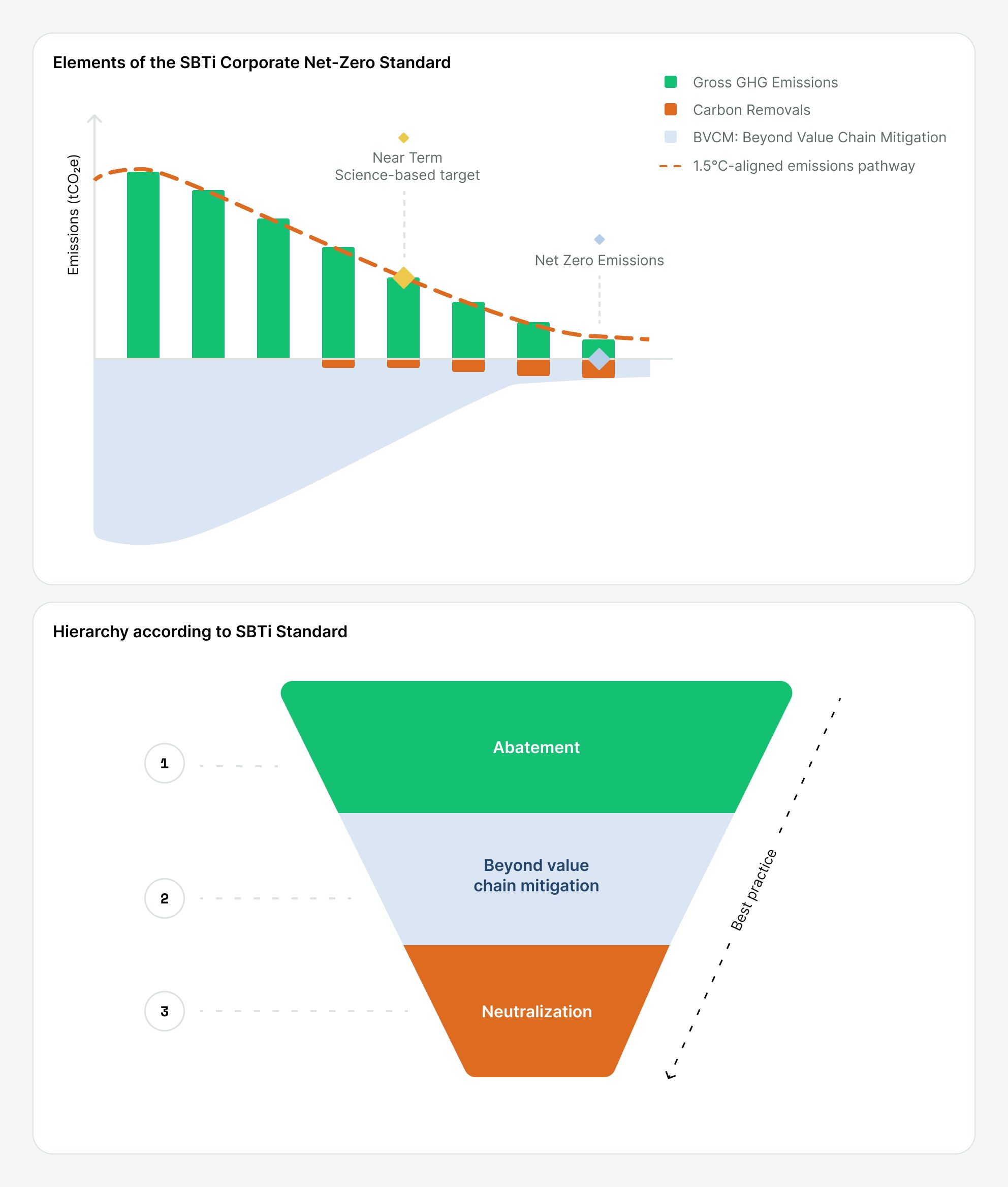A few hard facts to get you started:
Current data reveals that as of this year, 7,685 companies have set Science Based Targets to reduce emissions under the SBTi framework. Of these, 4,601 have been officially recognised by the SBTi (Science Based Targets Initiative). Compared to 2023, this results in 1,771 more companies following SBTi, of which a total of 106 companies come from Germany and thus a total increase of 1,329 officially confirmed science-based targets.
In its 2021 annual report, SBTi reported that the companies that have set validated targets using its method have a combined market capitalisation of $38 trillion, representing around a third of the global market value. In 2021, a total of 1.5 billion tonnes of CO₂ were recorded by these companies according to the SBTi standard, reducing CO₂ emissions by around 53 million tonnes this year alone.
The figures speak for themselves: more and more companies are deciding to set credible climate protection targets by pursuing science-based targets (SBTs) using the Science-Based Target Initiative (SBTi) standard. Supported by renowned organisations such as CDP, the UN Global Compact, WRI and WWF, the SBTi provides a structured and credible way for companies to set meaningful and achievable emissions reduction targets in line with the Paris Agreement.
In this blog post we talk about:
-
Briefly explained: Science-based targets and the SBTi framework.
-
The SBTi Corporate Net-Zero Standard and the current status quo 2024.
-
Why forest carbon projects are suitable as a BVCM investment under SBTi: Read more about how Tree.ly projects fit into the SBTi framework and what needs to be done as a next step.
What is SBTi? How is the framework structured?
The Science-Based Target Initiative (SBTi) is a co-operation between CDP, the UN Global Compact, the World Resources Institute (WRI) and the World Wide Fund for Nature (WWF). This initiative defines and supports best practices for reducing greenhouse gas (GHG) emissions. Companies receive technical support to declare science-based targets (SBTs). Through the SBTi Net-Zero Standard, they define a pioneering framework for companies to set net-zero targets.
Put simply, the Science-based-targets Initiative (SBTi) does the following:
-
Describes and supports optimal GHG reduction strategies to achieve the goal of net-zero in the context of science-based climate action
-
Provides methodologies and insights to help organisations set emission reduction targets.
-
Has a team of specialists and scientists who conduct unbiased assessments and verification of science-based targets.
How does the framework fit into the Net-Zero Goal?
The Corporate Net-Zero Standard: In October 2021, the SBTi published the Corporate Net-Zero Standard, which provides guidance, criteria and recommendations for companies to set long-term climate targets that are aligned with the overarching goal of limiting global temperature rise to 1.5°C. Both graphics visualise the underlying principle of the SBTi Net-Zero Standard: the hierarchy of emissions reduction and a clear recommendation on how companies should approach their target setting. The standard builds on the existing SBTi methodology, which enables companies to set short-term emission reduction targets, and defines three necessary steps towards Net-Zero (see graphic).

Companies can only claim to have achieved net zero when long-term, science-based targets are met for all areas and remaining emissions are continuously neutralised.
-
Step 1: "Abatement"- what does that mean?
The "bare minimum" for reduction towards net zero lies within the value chain of companies. SBTi uses the area shown here in green to illustrate which emissions need to be taken into account within short-term and long-term targets. In the short term, this means that companies must set 5-10 year targets to reduce emissions within their value chain in line with the path to the global net zero target. They need to set long-term science-based targets to reduce emissions within the value chain to a residual level in line with the 1.5°C scenario by 2050 at the latest.
-
Step 2: Beyond value chain mitigation
Beyond value chain mitigation concerns any emission reduction targets that lie outside a company's value chain. SBTi explicitly encourages companies to invest in immediate, consistent action (see grey area in the graphic) to go beyond the bare minimum. BVCM targets are essential on the road to net zero, even if they are voluntary, as is the next step described below.
-
Step 3: Neutralisation
The final absolutely necessary step towards sustainability is called neutralisation: companies must neutralise the climate impact of any remaining emissions outside the value chain in the net zero target year and all GHG emissions released into the atmosphere thereafter by permanently removing and storing carbon from the atmosphere. This area primarily includes nature-based solutions for efficient carbon sequestration and storage through, for example, (regional) forests and their sustainable management.
Criterion (C12) and recommendation (R9) - two particularly relevant regulations by SBTi that you should be aware of:
SBTi provides clear recommendations in the Net-Zero Standard on how CO₂ credits can be correctly included in sustainability reporting within the guidelines. The relevant rules for this are defined by the criterion (C12) and the recommendation (R9):
-
Criterion C12: The use of carbon credits must not be counted as an emission reduction towards the achievement of the companies' short-term or long-term science-based targets. They may only be used as an option to offset residual emissions that cannot be avoided or to finance additional climate protection measures that go beyond the defined targets.
-
R9 provides recommendations on BVCM investments: SBTi strongly recommends that companies make investments outside of their own value chains to mitigate GHG emissions in addition to their short- and long-term science-based targets. This includes annual support for projects, programmes and solutions that provide quantifiable climate benefits especially those that generate additional positive effects for people and nature - e.g. forest carbon offset projects. But what are the standards for these measures?
In February 2024, the Science Based Targets Initiative published specific standards for BVCM investments and their reporting as part of its Corporate Net-Zero Standard. This is primarily intended to improve credibility and counteract existing uncertainties on the part of investors. In June 2023, SBTi conducted a survey of companies to find out which aspects of BVCM activities should be regulated by SBTi. The results were published in summary form by the initiative in September and communicated this year in a comprehensive report.
In April, the Science Based Targets Initiative announced that - as part of the comprehensive revision of the Corporate Net-Zero Standard - the rules on the use of CO₂ certificates will be changed and also that SBTi will allow the use of such certificates to achieve Scope 3 targets. The conditions under which this will be possible and initial insights into the new draft are expected in the fourth quarter of 2024. However, it has already been communicated that the SBTi will publish its assessment of the evidence of the effectiveness of Environmental Attribute Certificates (EACs) in relation to companies' climate targets in July 2024. This is also expected to clarify the organization's position on CO₂ certificates.
In the next section you will learn what you can do now and why Tree.ly forest carbon projects are suitable as a BVCM investment under SBTi.
More than the "bare minimum"
Why it makes sense to invest in BVCM projects now:
We were able to show how the SBTi Corporate Net-Zero Standard is composed and what clear instructions are given for developing a best practice approach. SBTi makes a clear recommendation to invest in projects outside the value chain (BVCM) - despite current imprecise or missing guidance from SBTi, immediate investment in BVCM projects is sensible and necessary.
Our forest climate protection projects are focused on reducing emissions beyond value chain mitigation. As Natural-Based Solutions (NBS), they primarily involve projects aimed at preventing emissions by leveraging the natural ability of forests to absorb carbon. Additionally, these projects offer a limited opportunity for neutralizing residual emissions.
If you are wondering how you can include a Tree.ly forest carbon offset project in your sustainability report as part of the SBTi Corporate Net-Zero Standard, we have summarised here how our credits fit into this framework:
-
Buy carbon credits that have quality
Our methodology according to ISO-14064-2 is tried, tested and externally validated. It fulfils the highest quality standards in the forest project category. Our projects therefore represent a safe and effective investment in BVCM on your SBTi pathway. Our certificates must be disclosed as contribution claims separately from any offset certificates in your environmental reporting. Please also take into account the instructions on BVCM and the use of SBTi carbon credits in the Net-Zero Standard R9 and C12. Also observe the requirements of your ESG or sustainability reporting standard. We will be happy to provide you with examples and support you in communicating your contributions effectively and transparently.
-
We focus on regionality
We focus on regional forest climate protection. Why? In our blog series on sustainable forest management in Central Europe, we make it clear why European forests need our support more than ever. Read now part one of the series here. Our projects promote regional forest management and the preservation and expansion of regional, natural carbon sinks - our forests in Europe. If you invest in regional projects, you also invest in their co-benefits, which have direct advantages for the region and the people who live there.
-
Concrete action plans with the forest owners
So that you can find out more about what will be done for the local forest after your investment in a Tree.ly project, we draw up concrete action plans with the forest owners of the project areas and share with you transparently what is to be implemented specifically for regional climate protection. You will receive access to our project register and their documentation plans. We also want to enable you and your employees to take a break in the forest: We are happy to help you with this and organise a walk & talk between you and the forest owner of the project area you are supporting.
Stay informed
Let's unlock the full potential of forests. Together.
Stay up to date, we will inform you about upcoming updates regarding guidelines and framework conditions in our newsletter. Would you like to know what your Tree.ly project report could look like as an example?


